Stephane Pannemaker Paintings
Stéphane Pannemaker was a distinguished French engraver, born in Paris in 1847. His contributions to the art world during the 19th and early 20th centuries were significant, especially in the realm of wood engraving, a technique that was pivotal in the reproduction of artworks and illustrations in publications during that era. Pannemaker's skill in engraving was not just technical but also deeply artistic, allowing for the detailed and sensitive translation of paintings and drawings into prints that could be widely disseminated.
Pannemaker's career was marked by his collaboration with numerous prominent artists of his time, serving as a bridge between the original artworks and the public. His engravings were featured in various important publications, magazines, and books, making the works of art accessible to a broader audience and playing a crucial role in the dissemination of visual culture. He was particularly adept at capturing the nuances of the original works, a skill that garnered him widespread acclaim within artistic circles.
Throughout his life, Pannemaker received several honors, reflecting his status as one of the leading engravers of his day. His work is characterized by a meticulous attention to detail and a deep respect for the original artists' intentions, qualities that made his engravings sought after by publishers and collectors alike. Despite the changes in artistic tastes and technologies over time, Pannemaker's contributions to the field of engraving remain an important part of the history of art reproduction.
He lived through a period of significant change in the art world, witnessing the shifts from Romanticism to Realism, and finally to Impressionism and beyond. Yet, he managed to maintain his relevance and artistic integrity throughout these transitions, adapting his style to meet the demands of the times while preserving the essence of the works he reproduced. Pannemaker's legacy is not only in the beautiful engravings he left behind but also in his role in making art more accessible to the masses. He passed away in 1930, leaving behind a rich body of work that continues to be studied and appreciated by art historians and enthusiasts alike.
